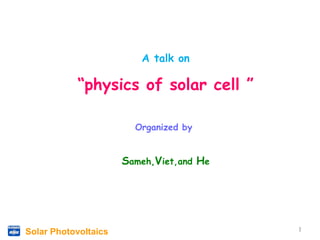
physics of solar cell
- 1. Solar Photovoltaics A talk on “physics of solar cell ” Organized by Sameh,Viet,and He 11
- 2. Solar Photovoltaics SolarCells The heart of a PV system, are meant to absorb sunlight and convert it directly to electricity, they rely on the photoelectric effect( the ability of matter to emit electrons when a light incident on it). Physics of solarcells For best solar energy conversion the optimum band gap is ~ 1.0 - 1.5 eV. Some of the best solar cell materials are: Silicon (1.12 eV), GaAs (1.42 eV), CdTe (~1.44 22
- 3. Solar Photovoltaics Band Structure Consider a semiconductor at T = 0 K, then there is no electrons in the conduction band. At T > 0 K a small fraction of electrons are thermally excited into the conduction band, “leaving” the same number of 33
- 4. Solar Photovoltaics Extrinsic Semiconductors Electrical Properties of Semiconductors: It can be changed drastically by adding a small amounts of suitable impurities to the pure crystals(doping). Types of impurities atoms: – Interstitial: “foreign” atoms “squeezed” between regular crystal sites. – Substitutional: “foreign” atoms occupying the sites of host atoms 44
- 5. Solar Photovoltaics Doping Doping The addition of some impurities into a semiconductor according to our requirements. In other words, impurities are introduced in a controlled manner to change the conductivity of the material. Silicon – Doping (n-type & p-type) • N-type semiconductors (for ex. doping with Phosphorous) • P-type semiconductors.(for ex. doping with 55
- 6. Solar Photovoltaics Donors We use Silicon (Si) as an example – Si atoms have four valence electrons that participate in covalent bonding – When a Group V atom replaces a Si atom, it will use four of its electrons to form the covalent bonding. The remaining electron will not be very tightly 66
- 7. Solar Photovoltaics Donors: Energy Levels The Band Structure View Such impurities “create” an energy level within the band gap, close to the conduction band They create so-called “shallow” levels , the levels that are very close to the conduction band, so the energy required to ionize the atom is small and a sizable fraction of donor atoms will be ionized at 77
- 8. Solar Photovoltaics The Single Crystalline SolarCell Pure silicon is a poor conductor of electricity. “Doping” of silicon with phosphorus and boron is necessary to create n-type and p-type regions ,this allows presence of free electrons and holes. The p-n junction generates an electric field that acts as a diode, pushing electrons to flow from the P side to the N side. 88
- 9. Solar Photovoltaics The N-type material is keep thin to allow light to pass through to the PN junction. 99
- 10. 1010
- 15. Solar Photovoltaics The solar spectrum Sunlight consists of a broad range of spectrum The photon energy depends on the photon wavelength: Ephot = hc/λ Harnessing the great amount of sunlight to energy 1515
- 16. Solar Photovoltaics Theoretical efficiency limits of single junction solar cells made out of various semiconductors Energy Band Gaps in solar cell materials 1616
- 17. Solar Photovoltaics Acceptors Substitute one Group III atom (e.g. Al or In) with a Si (Group IV) atom At T > 0 K, electron from the neighboring Si atom can jump into this hole – the hole starts to migrate, contributing to the current At T > 0 K this hole can be ionized Such semiconductors are called p-type semiconductors since they contribute positive charge carriers 1717
- 18. Solar Photovoltaics Acceptor: Energy Levels From the Band Structure View – Such impurities “create” energy levels within the band gap, close to the valence band – They are similar to “negative” hydrogen atoms – Such impurities are called hydrogenic acceptors – They create “shallow” levels - levels that are very close to the valence band, so the energy required to ionize the atom (accept the electron that fills the hole and creates another hole further from the substituted atom) is small 1818
- 19. Solar Photovoltaics Types of silicon used for making solar cells Type of Silicon Abbreviation Crystal Size Range Method for Production Single-crystal silicon c-Si >10cm Crystal growth by Czochralski (CZ), Float zone (FZ) Multicrystalline silicon mc-Si 1mm-10cm Cast : Sheet & ribbon Micro crystalline silicon µc-Si 0.1 µm – 1 µm Plasma Enhanced Chemical-vapor deposition (PECVD) Nano crystalline silicon nc-Si <<1 µm PECVD Amorphous silicon a-Si Crystallites absent PECVD 1919
Hinweis der Redaktion
- Valence band : is the highest range of electron energies in which electrons are normally present at 0 K temperature. Conduction band :is the lowest energy level in which there are no electrons present at 0 K temperature.
- A substitutional impurity atom : is an atom of a different type than the bulk atoms, which has replaced one of the bulk atoms in the lattice Interstitial impurity atoms : fit into the open space between the bulk atoms of the lattice structure.
- Visible Light : nearly in the range from 400 – 750 nm
